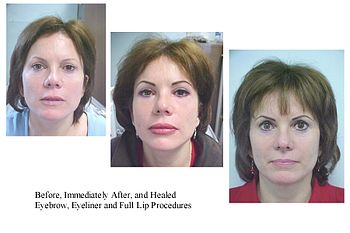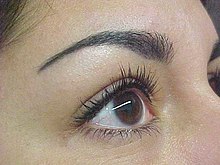Permanent makeup

Permanent makeup is a cosmetic technique which employs tattoos (permanent pigmentation of the dermis) as a means of producing designs that resemble makeup, such as eyelining and other permanent enhancing colors to the skin of the face, lips, and eyelids. It is also used to produce artificial eyebrows, particularly in people who have lost them as a consequence of old age, disease, such as alopecia totalis, chemotherapy, or a genetic disturbance, and to disguise scars and white spots in the skin such as in vitiligo. It is also used to restore or enhance the breast's areola, such as after breast surgery.
Most commonly called permanent cosmetics, other names include dermapigmentation, micropigmentation, and cosmetic tattooing,[1] the latter being most appropriate since permanent makeup is, in fact, tattooing. In the United States and under similar arrangements in some other countries, the colourant additives used in permanent makeup pigments are subject to pre market approval as cosmetics and or color additives under the Federal Food, Drug, and Cosmetic Act. However, because of other competing public health priorities and a previous lack of evidence of safety problems specifically associated with these pigments, FDA traditionally has not exercised regulatory authority for color additives on the pigments used in tattoo inks.[2]
History
Permanent makeup dates back at least to the start of the 20th century, though its nature was often concealed in its early days. The tattooist George Burchett, a major developer of the technique when it become fashionable in the 1930s, described in his memoirs how beauty salons tattooed many women without their knowledge, offering it as a "complexion treatment ... of injecting vegetable dyes under the top layer of the skin."[3][4]
Results
Immediate results
Permanent makeup results in enhanced features of the face—definition is rendered to eyebrows, eyes and lips by the use of colors. Results can imitate topically applied cosmetics or can be quite unnoticeable, depending upon the design, color value and amount of pigment used.
At first, permanent makeup results may look darker. This is due to colour remaining in the outermost epidermal layers of skin at the start. Colour softens within a few days during the healing process as the upper layers of epidermis slough and are replaced by new epidermal cells.
Long-term results
The best possible colour results can perform for many years or may begin to fade over time. The amount of time required for this, depends per person. While permanent makeup pigment remains in the dermis its beauty-span may be influenced by several possible factors. These can be environmental, procedural and/or individual factors.[5] Sun exposure fades colour. The amount and colour of pigment deposit at the dermal level can affect the length of time that permanent makeup looks its best. Very natural-looking applications are likely to require a touch-up before more dramatic ones for this reason. Individual influences include lifestyles that find an individual in the sun regularly such as with gardening or swimming. Skin tones are a factor in colour value changes over time.
Imperfections
There are cases, of undesired results.[6] The four most common complaints are "too dark," "wrong colour," "uneven" and "too big." A skilled, experienced, permanent makeup professional is able to adjust the colour and evenness of permanent makeup results in most cases. A design that is too large presents a serious challenge, however. Costly pigment lightening techniques and/or removal may be the only solutions.
Removal
As with tattoos, permanent makeup can be difficult to remove. Common techniques used for this are laser resurfacing, dermabrasion (physical or chemical exfoliation), and surgical removal. Camouflaging—adding a new pigment which counteracts the tattoo color and attempts to emulate normal skin color is considered a poor choice by professionals. Removal is more painful and laborious than the tattooing itself.
The choice to get a tattoo that is later regretted is related to the end-of-history illusion, in which teenagers and adults of all ages know that their tastes and preferred fashion and makeup styles have changed regularly over the years before the current moment, but they believe that their tastes will somehow not continue to grow and mature in the future.[7]
Adverse effects and complications
As with tattoos, permanent makeup may have complications, such as allergies to the pigments, formation of scars, granulomas and keloids, skin cracking, peeling, blistering and local infection.[8] The use of unsterilized tattooing instruments may infect the patient with serious diseases such as HIV and hepatitis. Removal problems may also ensue, due to patient dissatisfaction or regret, and they may be particularly difficult to remove in places such as eyelids and lips without leaving permanent sequelae. Compliance with 'standard precautions' and a uniform code of safe practice should be insisted upon by a person considering undergoing a cosmetic tattoo procedure.[9] [10]
It is essential that technicians use appropriate personal protective equipment to protect the health of the technician and the client particularly in the prevention of transmission of blood borne pathogens.[11]
On very rare occasions, people with permanent makeup have reported swelling or burning in the affected areas when they underwent magnetic resonance imaging (MRI).[12] However a detailed review of the cases within the medical literature involving cosmetic tattoos indicates that poor quality pigments, pigments adulterated with heavy metals, and pigments with diametric magnetic properties may have been the causative factors in most of those cases.[13] [14]
Topical anaesthetics are often used by technicians prior to Cosmetic Tattooing and there is the potential for adverse effects if topical anaesthetics are not used safely, in 2013 the International Industry association CosmeticTattoo.org published a detailed position and general safety precautions for the entire industry.[15]
The causes of a change of colour after cosmetic tattooing are both complex and varied, as is discussed in the detailed industry article "Why Do Cosmetic Tattoos Change Colour",[16] primarily there are four main areas that have influence over the potential for a cosmetic tattoo to change colour;
1) Factors related to the pigment characteristics
2) Factors related to the methods and techniques of the tattooist
3) Factors intrinsic to the client
4) Factors related to the client's environment and medicines
Technicians need to have a comprehensive understanding of these influences to achieve more predictable outcomes for their clients.
Examples

This client had her eyebrows and top eyeliner permanently tattooed. The eyebrow tattooing is an example of a "powdery filled" technique as opposed to individual hairline strokes since the client already has eyebrow hair but simply wanted an enhancement and shaping. The top eyeliner represents a thin eyeliner tattoo and a "lash enhancement" procedure that is used to define the eye without making it look excessively made up.
References
- ^ Industry Profile Study: Vision 2009
- ^ Tattoos and Permanent Makeup: Fact Sheet
- ^ Revolting Bodies: The Monster Beauty of Tattooed Women, Christine Braunberger, NWSA Journal Volume 12, Number 2
- ^ "Lip Tattooing Is the Latest Fad". Moder Mechanix. January 1933. Retrieved 18 February 2009.
{{cite journal}}: Cite has empty unknown parameters:|laydate=,|laysource=, and|laysummary=(help) - ^ Position on Semi-Permanent Makeup, Society of Permanent Cosmetic Professionals
- ^ FDA on Tattoos and Permanent Makeup
- ^ Tierney, John (4 January 2013). "You Won't Stay the Same, Study Finds". The New York Times. Retrieved 6 January 2013.
- ^ FDA: Tattoo Pigment Recalls
- ^ Code of Ethics & Conduct: Detailed recommended industry standards for safe practice
- ^ SPCP code of Ethics
- ^ Personal Protective Equipment - Are You Covered?
- ^ http://www.ajronline.org/doi/full/10.2214/AJR.06.5082
- ^ CosmeticTattoo.org Review: Cosmetic Tattooing & MRI’s - Diametric Particle Agitation Hypothesis (DPA)
- ^ SPCP Research into Tattooing and MRIs
- ^ CosmeticTattoo.org Position Statement: Topical Anaesthetics & Cosmetic Procedures
- ^ Why Do Cosmetic Tattoos Change Colour?
